What is Check-this.one?
Check-this.one is a website which uses the browser notification feature to lure you and other unsuspecting victims into allowing push notifications from malicious (ad) push servers. Although push notifications cannot harm you directly, scammers use them to display annoying ads, promote adware software bundles, and encourage you to visit malicious web-sites.
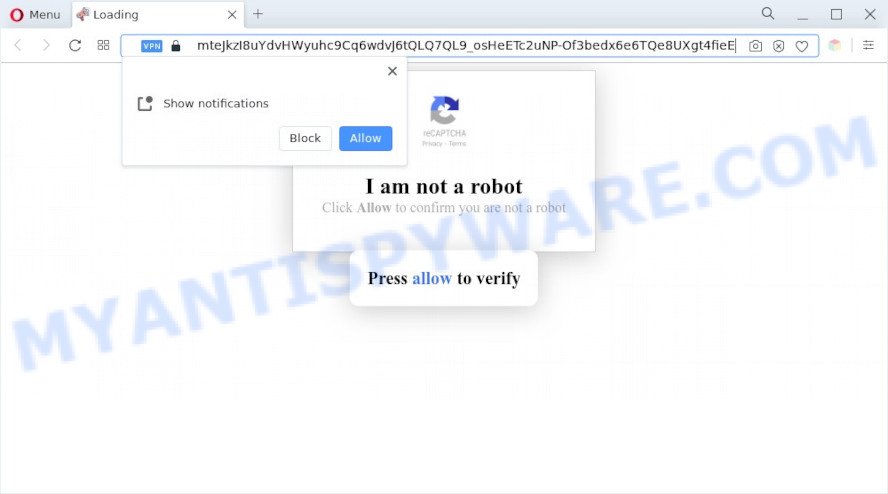
The Check-this.one web-site shows the message ‘Click Allow to’ (download a file, enable Flash Player, access the content of the web site, connect to the Internet, watch a video), asking you to subscribe to notifications. Once you click the ‘Allow’ button, you will start seeing unwanted ads in form of pop up windows on the screen.

Threat Summary
| Name | Check-this.one popup |
| Type | browser notification spam, spam push notifications, pop-up virus |
| Distribution | misleading popup ads, potentially unwanted software, adware software, social engineering attack |
| Symptoms |
|
| Removal | Check-this.one removal guide |
How does your PC get infected with Check-this.one popups
These Check-this.one pop-ups are caused by malicious advertisements on the web-sites you visit or adware. Adware is considered by many to be synonymous with ‘malicious software’. It is a form of harmful programs which show unwanted ads to computer users. Some examples include popup ads, push notifications or unclosable windows. Adware can be installed onto computers via infected web sites, when users open email attachments, anytime users download and install freeware.
Adware software is bundled with some free applications. So always read carefully the install screens, disclaimers, ‘Terms of Use’ and ‘Software license’ appearing during the install procedure. Additionally pay attention for third-party software that are being installed along with the main program. Ensure that you unchecked all of them! Also, use an ad-blocking program that will help to stop malicious and illegitimate web sites.
Remove Check-this.one notifications from browsers
If you are in situation where you don’t want to see push notifications from the Check-this.one web-site. In this case, you can turn off web notifications for your web browser in Microsoft Windows/Apple Mac/Android. Find your internet browser in the list below, follow step-by-step instructions to remove internet browser permissions to display notifications.
Google Chrome:
- Just copy and paste the following text into the address bar of Chrome.
- chrome://settings/content/notifications
- Press Enter.
- Remove the Check-this.one URL and other dubious URLs by clicking three vertical dots button next to each and selecting ‘Remove’.
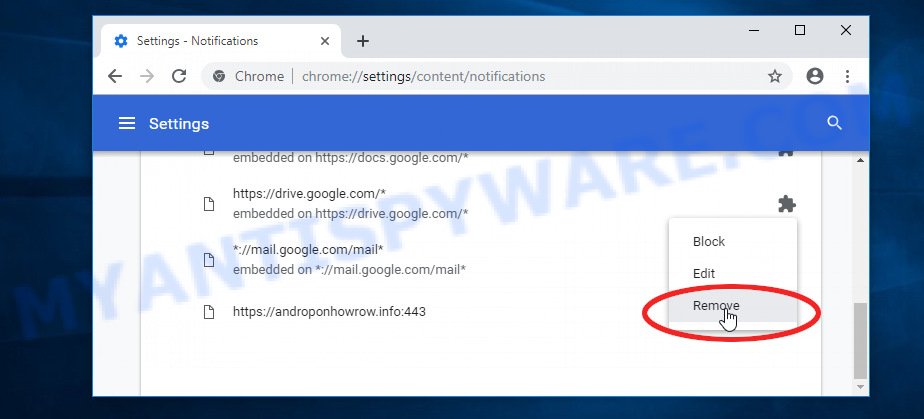
Android:
- Tap ‘Settings’.
- Tap ‘Notifications’.
- Find and tap the browser which shows Check-this.one browser notifications ads.
- Locate Check-this.one URL in the list and disable it.
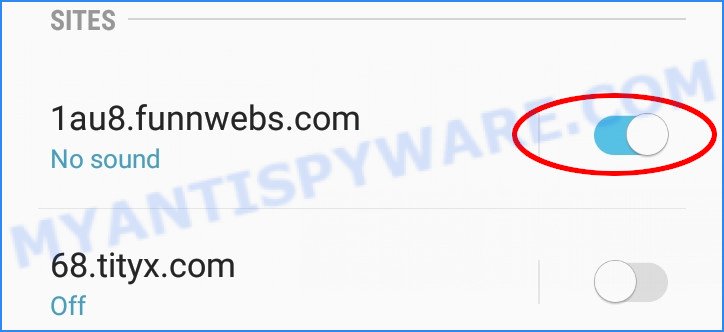
Mozilla Firefox:
- In the right upper corner, click the Firefox menu (three horizontal stripes).
- Choose ‘Options’ and click on ‘Privacy & Security’ on the left hand side of the Firefox.
- Scroll down to ‘Permissions’ and then to ‘Settings’ next to ‘Notifications’.
- Locate sites you down’t want to see notifications from (for example, Check-this.one), click on drop-down menu next to each and select ‘Block’.
- Click ‘Save Changes’ button.
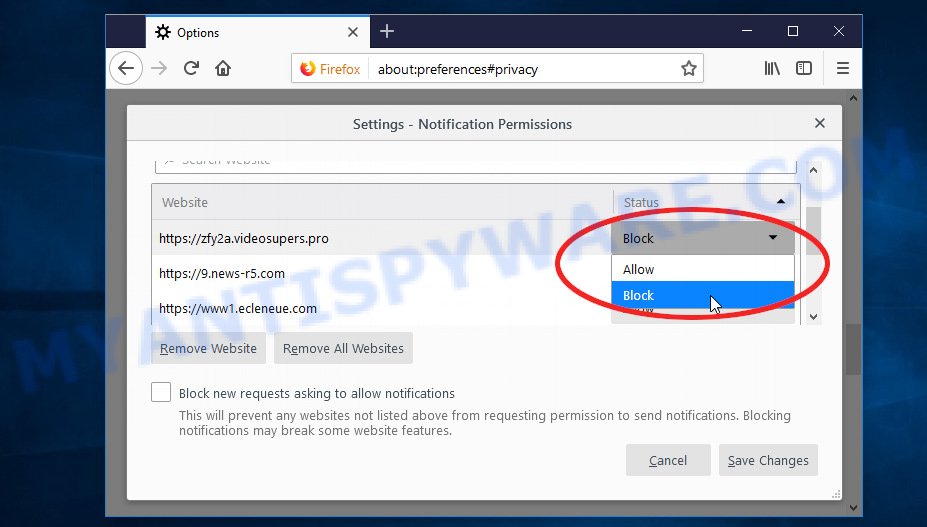
Edge:
- In the right upper corner, click the Edge menu button (it looks like three dots).
- Scroll down to ‘Settings’. In the menu on the left go to ‘Advanced’.
- Click ‘Manage permissions’ button below ‘Website permissions’.
- Click the switch under the Check-this.one site and each questionable domain.
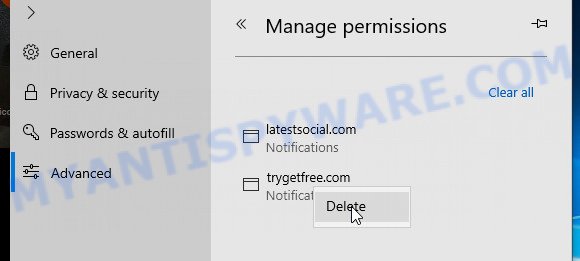
Internet Explorer:
- Click the Gear button on the top right hand corner of the browser.
- When the drop-down menu appears, click on ‘Internet Options’.
- Select the ‘Privacy’ tab and click ‘Settings below ‘Pop-up Blocker’ section.
- Find the Check-this.one and click the ‘Remove’ button to remove the domain.
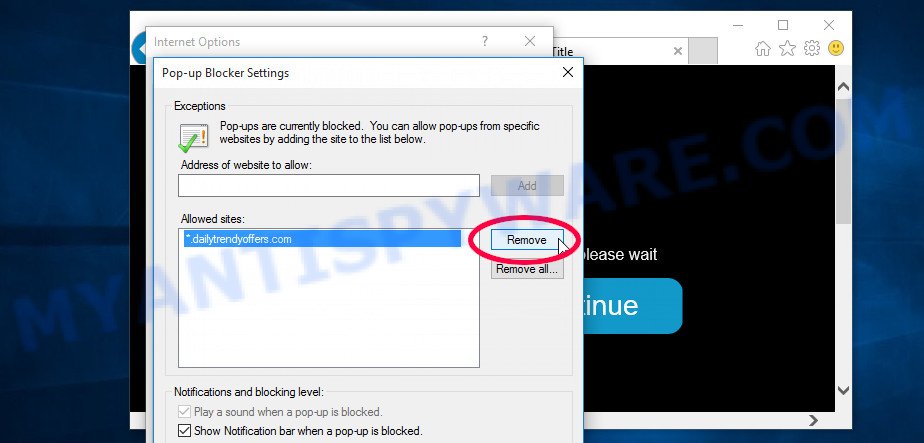
Safari:
- Click ‘Safari’ button on the top left hand corner and select ‘Preferences’.
- Select the ‘Websites’ tab and then select ‘Notifications’ section on the left panel.
- Find the Check-this.one site and select it, click the ‘Deny’ button.
How to remove Check-this.one pop-up advertisements (removal guide)
There are a few ways which can be used to remove Check-this.one pop up advertisements. But, not all PUPs such as this adware can be completely uninstalled utilizing only manual ways. Most commonly you are not able to uninstall any adware software utilizing standard Windows options. In order to remove Check-this.one popups you need complete a few manual steps and run reliable removal tools. Most experienced security specialists states that Zemana AntiMalware, MalwareBytes or Hitman Pro utilities are a right choice. These free programs are able to detect and remove Check-this.one popup ads from your computer and revert back your web-browser settings to defaults.
To remove Check-this.one pop ups, execute the steps below:
- Remove Check-this.one notifications from browsers
- Manual Check-this.one ads removal
- Automatic Removal of Check-this.one advertisements
- Stop Check-this.one ads
Manual Check-this.one ads removal
In most cases, it is possible to manually get rid of Check-this.one popup advertisements. This way does not involve the use of any tricks or removal tools. You just need to restore the normal settings of the PC system and web browser. This can be done by following a few simple steps below. If you want to quickly get rid of Check-this.one pop-up ads, as well as perform a full scan of your PC system, we recommend that you run adware removal utilities, which are listed below.
Uninstall PUPs using Windows Control Panel
First, go to MS Windows Control Panel and uninstall questionable programs, all programs you do not remember installing. It’s important to pay the most attention to apps you installed just before Check-this.one advertisements appeared on your web browser. If you do not know what a program does, look for the answer on the Net.
Windows 10, 8.1, 8
Click the MS Windows logo, and then click Search ![]() . Type ‘Control panel’and press Enter as displayed in the figure below.
. Type ‘Control panel’and press Enter as displayed in the figure below.
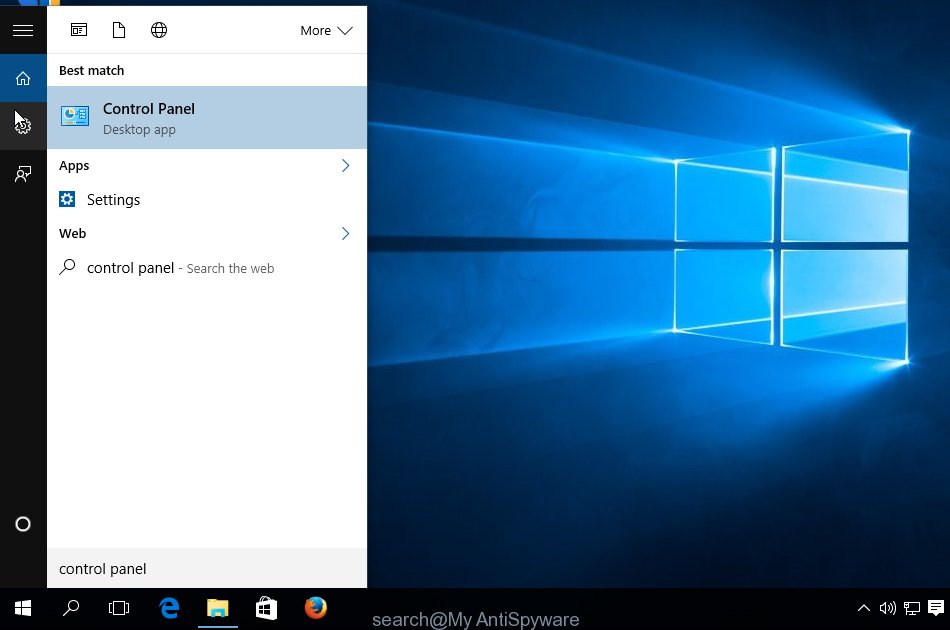
When the ‘Control Panel’ opens, click the ‘Uninstall a program’ link under Programs category as displayed on the image below.
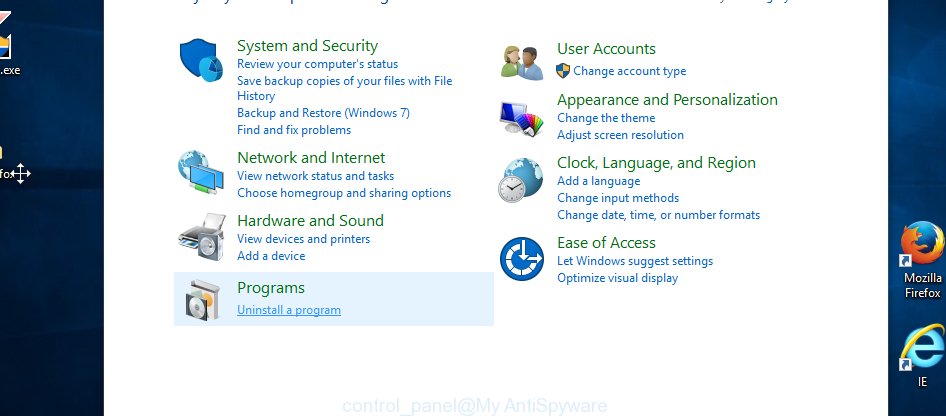
Windows 7, Vista, XP
Open Start menu and choose the ‘Control Panel’ at right such as the one below.
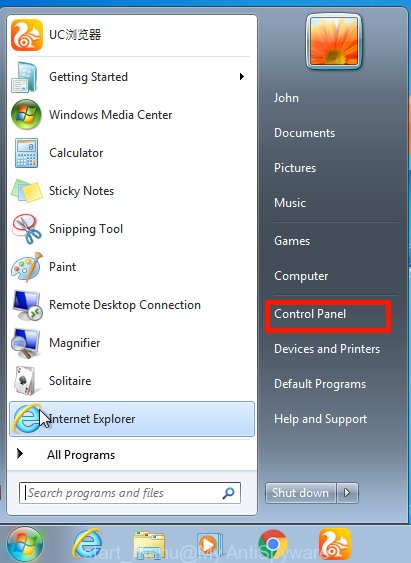
Then go to ‘Add/Remove Programs’ or ‘Uninstall a program’ (Microsoft Windows 7 or Vista) as displayed on the screen below.
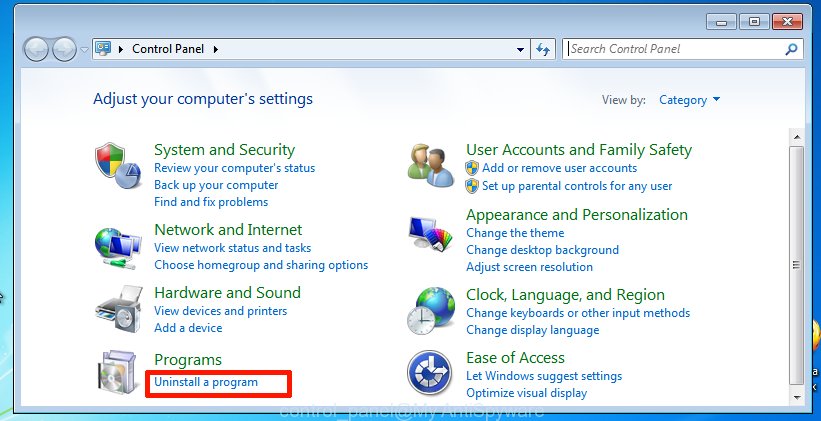
Carefully browse through the list of installed applications and remove all dubious and unknown apps. We advise to press ‘Installed programs’ and even sorts all installed applications by date. Once you have found anything questionable that may be the adware software that causes multiple annoying popups or other potentially unwanted program (PUP), then select this application and click ‘Uninstall’ in the upper part of the window. If the suspicious program blocked from removal, then run Revo Uninstaller Freeware to completely delete it from your computer.
Remove Check-this.one ads from Microsoft Internet Explorer
If you find that Internet Explorer browser settings such as homepage, search provider by default and new tab page had been changed by adware that causes multiple intrusive pop ups, then you may revert back your settings, via the reset web-browser procedure.
First, open the Internet Explorer, then click ‘gear’ icon ![]() . It will show the Tools drop-down menu on the right part of the web-browser, then click the “Internet Options” as displayed in the following example.
. It will show the Tools drop-down menu on the right part of the web-browser, then click the “Internet Options” as displayed in the following example.

In the “Internet Options” screen, select the “Advanced” tab, then click the “Reset” button. The IE will open the “Reset Internet Explorer settings” dialog box. Further, click the “Delete personal settings” check box to select it. Next, press the “Reset” button as shown below.

Once the procedure is complete, click “Close” button. Close the IE and restart your computer for the changes to take effect. This step will help you to restore your browser’s search provider by default, new tab and home page to default state.
Remove Check-this.one popup advertisements from Chrome
Use the Reset browser utility of the Chrome to reset all its settings such as home page, default search engine and newtab page to original defaults. This is a very useful utility to use, in the case of browser redirects to unwanted ad web-pages like Check-this.one.
Open the Chrome menu by clicking on the button in the form of three horizontal dotes (![]() ). It will open the drop-down menu. Select More Tools, then press Extensions.
). It will open the drop-down menu. Select More Tools, then press Extensions.
Carefully browse through the list of installed extensions. If the list has the plugin labeled with “Installed by enterprise policy” or “Installed by your administrator”, then complete the following instructions: Remove Chrome extensions installed by enterprise policy otherwise, just go to the step below.
Open the Chrome main menu again, click to “Settings” option.

Scroll down to the bottom of the page and click on the “Advanced” link. Now scroll down until the Reset settings section is visible, like below and click the “Reset settings to their original defaults” button.

Confirm your action, click the “Reset” button.
Delete Check-this.one from Firefox by resetting web-browser settings
Resetting your Firefox is first troubleshooting step for any issues with your web browser program, including the redirect to Check-this.one website. Essential information such as bookmarks, browsing history, passwords, cookies, auto-fill data and personal dictionaries will not be removed.
First, run the Firefox and click ![]() button. It will open the drop-down menu on the right-part of the internet browser. Further, click the Help button (
button. It will open the drop-down menu on the right-part of the internet browser. Further, click the Help button (![]() ) as on the image below.
) as on the image below.

In the Help menu, select the “Troubleshooting Information” option. Another way to open the “Troubleshooting Information” screen – type “about:support” in the browser adress bar and press Enter. It will show the “Troubleshooting Information” page like below. In the upper-right corner of this screen, click the “Refresh Firefox” button.

It will open the confirmation prompt. Further, press the “Refresh Firefox” button. The Mozilla Firefox will begin a task to fix your problems that caused by the Check-this.one adware software. Once, it’s complete, click the “Finish” button.
Automatic Removal of Check-this.one advertisements
If the Check-this.one popup advertisements are still there, the situation is more serious. But don’t worry. There are several utilities that are developed to detect and get rid of adware from your internet browser and PC system. If you’re looking for a free method to adware removal, then Zemana Anti-Malware is a good option. Also you can get Hitman Pro and MalwareBytes Anti Malware (MBAM). Both programs also available for free unlimited scanning and for removal of detected malware, adware and potentially unwanted apps.
Get rid of Check-this.one ads with Zemana Free
Zemana Free is a malware removal utility developed for Windows. This tool will help you remove Check-this.one popups, various types of malware (including browser hijackers and potentially unwanted programs) from your personal computer. It has simple and user friendly interface. While the Zemana AntiMalware does its job, your device will run smoothly.
Installing the Zemana is simple. First you will need to download Zemana Free on your Microsoft Windows Desktop by clicking on the following link.
165511 downloads
Author: Zemana Ltd
Category: Security tools
Update: July 16, 2019
After the download is finished, close all apps and windows on your device. Open a directory in which you saved it. Double-click on the icon that’s named Zemana.AntiMalware.Setup as displayed below.
![]()
When the install begins, you will see the “Setup wizard” which will help you setup Zemana Anti-Malware (ZAM) on your PC system.

Once install is done, you will see window as shown on the screen below.

Now click the “Scan” button to perform a system scan with this tool for the adware that causes the annoying Check-this.one pop ups. This process can take some time, so please be patient.

When Zemana Anti-Malware (ZAM) has completed scanning your PC, Zemana AntiMalware will produce a list of unwanted programs and adware software. Once you’ve selected what you wish to remove from your device click “Next” button.

The Zemana Free will delete adware that causes popups and move the selected threats to the program’s quarantine.
Remove Check-this.one popups and harmful extensions with HitmanPro
HitmanPro is a free portable program that scans your device for adware that causes Check-this.one ads, PUPs and hijackers and helps get rid of them easily. Moreover, it’ll also help you get rid of any malicious internet browser extensions and add-ons.

- Download HitmanPro by clicking on the following link.
- When the downloading process is done, double click the HitmanPro icon. Once this tool is opened, click “Next” button to perform a system scan for the adware that causes Check-this.one ads in your web browser. This procedure may take quite a while, so please be patient.
- When that process is done, Hitman Pro will show a list of detected threats. You may remove items (move to Quarantine) by simply click “Next” button. Now click the “Activate free license” button to begin the free 30 days trial to get rid of all malware found.
Use MalwareBytes to remove Check-this.one pop ups
Get rid of Check-this.one popups manually is difficult and often the adware is not fully removed. Therefore, we recommend you to run the MalwareBytes Free that are completely clean your personal computer. Moreover, this free program will help you to remove malware, potentially unwanted software, toolbars and hijackers that your computer can be infected too.
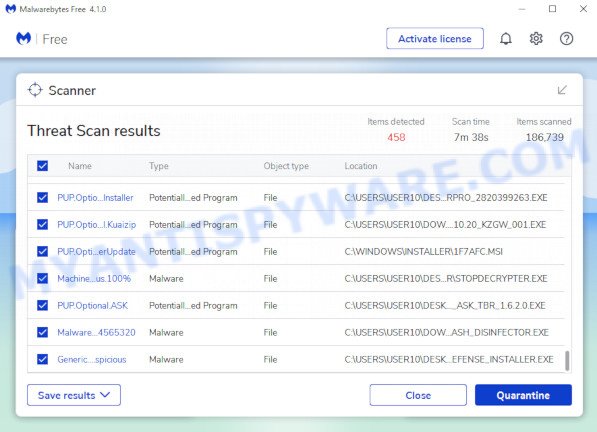
- First, visit the following page, then click the ‘Download’ button in order to download the latest version of MalwareBytes Anti Malware.
Malwarebytes Anti-malware
327733 downloads
Author: Malwarebytes
Category: Security tools
Update: April 15, 2020
- At the download page, click on the Download button. Your browser will show the “Save as” prompt. Please save it onto your Windows desktop.
- After the download is done, please close all apps and open windows on your PC system. Double-click on the icon that’s called MBSetup.
- This will open the Setup wizard of MalwareBytes onto your computer. Follow the prompts and do not make any changes to default settings.
- When the Setup wizard has finished installing, the MalwareBytes Anti-Malware will open and show the main window.
- Further, press the “Scan” button to perform a system scan for the adware software related to the Check-this.one popups. A system scan can take anywhere from 5 to 30 minutes, depending on your PC system. While the MalwareBytes AntiMalware utility is checking, you can see how many objects it has identified as being affected by malware.
- Once that process is complete, the results are displayed in the scan report.
- Review the scan results and then click the “Quarantine” button. Once the procedure is finished, you may be prompted to reboot the personal computer.
- Close the Anti-Malware and continue with the next step.
Video instruction, which reveals in detail the steps above.
Stop Check-this.one ads
By installing an ad-blocking application such as AdGuard, you are able to block Check-this.one, autoplaying video ads and get rid of a large number of distracting and intrusive ads on web-sites.
AdGuard can be downloaded from the following link. Save it on your Microsoft Windows desktop or in any other place.
27037 downloads
Version: 6.4
Author: © Adguard
Category: Security tools
Update: November 15, 2018
Once the downloading process is done, start the downloaded file. You will see the “Setup Wizard” screen as shown on the screen below.

Follow the prompts. When the installation is complete, you will see a window as shown in the following example.

You can click “Skip” to close the setup application and use the default settings, or click “Get Started” button to see an quick tutorial that will assist you get to know AdGuard better.
In most cases, the default settings are enough and you do not need to change anything. Each time, when you launch your device, AdGuard will start automatically and stop undesired advertisements, block Check-this.one, as well as other malicious or misleading web-pages. For an overview of all the features of the program, or to change its settings you can simply double-click on the AdGuard icon, which can be found on your desktop.
To sum up
Now your PC should be free of the adware that causes multiple unwanted pop ups. We suggest that you keep Zemana AntiMalware (to periodically scan your PC for new adware softwares and other malware) and AdGuard (to help you block intrusive pop-ups and malicious web sites). Moreover, to prevent any adware software, please stay clear of unknown and third party apps, make sure that your antivirus program, turn on the option to detect PUPs.
If you need more help with Check-this.one pop up ads related issues, go to here.



















